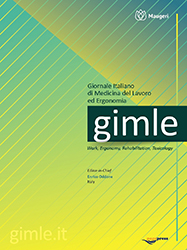Work-related stress, quality of life, and positivity among bank employees
All claims expressed in this article are solely those of the authors and do not necessarily represent those of their affiliated organizations, or those of the publisher, the editors and the reviewers. Any product that may be evaluated in this article or claim that may be made by its manufacturer is not guaranteed or endorsed by the publisher.
Authors
Background. The present study aimed to analyze the levels of work-related stress and perceived well-being among employees of cooperative credit banks (BCCs) in the Veneto region (Italy). The risk of stress was assessed using Karasek’s Job Demand-Control (JDC) model.
Methods. An anonymous online questionnaire was administered via email to workers registered with trade unions, covering 91% of the total workers. The study collected socio-demographic and work-related information between April and June 2021 using the following validated questionnaires: the Bank Employee Stress Test 8 (BEST8), the Job Content Questionnaire (JCQ) by Karasek, the Short-Form (SF)-12 Health Survey, and the Positivity Scale (PS). A logistic regression analysis was used to assess the significant associations between quality of life (QoL) and potential stressors.
Results. A total of 1,506 questionnaires were collected, with a response rate of 38%. Fifty-eight percent of the participants were male, with an average age of 45 years (standard deviation [SD]=8.2). Regarding QoL, the average physical component score (PCS) was 52.3 (95% confidence interval [CI]: 51.9-52.7), while the mental component score (MCS) was 35.9 (95% CI: 35.5-36.6), which is significantly lower than the average for the Italian population, typically ranging from 48 to 51.7. According to the JCQ, the mean decision latitude (DL) reported by participants was 65.7, and the mean job demand (JD) was 38.5. Overall, 24.3% of the workers were found to be in a state of distress. The regression model showed that distress was significantly associated with anxiety over unmet budget targets due to potential relocation or role changes, difficulty adapting to a fast-paced work environment, moral conflict with sales or consultation demands, and pressure from colleagues or superiors to be more flexible. The model demonstrated a goodness-of-fit of 46%.
Conclusions. The “contextual stressors” identified in this study appear to be linked to organizational culture, career development opportunities, decision-making autonomy, and the level of control given to employees. On the other hand, the “content-related stressors” are connected to the intensity and pace of work. The QoL among workers was significantly lower than the national average. From an epidemiological standpoint, these findings offer valuable insights for future studies aimed at better understanding the causal relationship between stressors and health outcomes, and they may also encourage the implementation of health prevention and stress management interventions.
How to Cite

This work is licensed under a Creative Commons Attribution-NonCommercial 4.0 International License.
PAGEPress has chosen to apply the Creative Commons Attribution NonCommercial 4.0 International License (CC BY-NC 4.0) to all manuscripts to be published.






